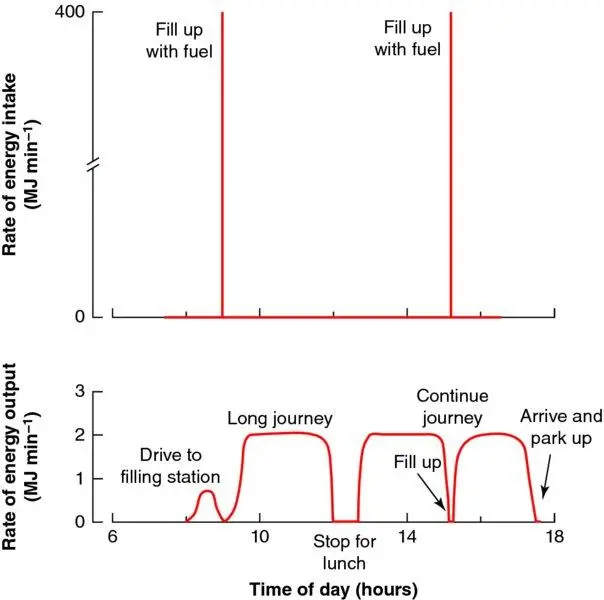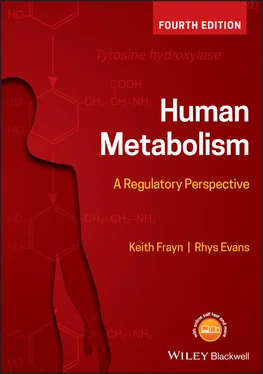This book is accompanied by a companion website:

www.wiley.com/go/frayn
The website includes:
PowerPoint slides of all the figures in the book for downloading
Multiple choice questions
Key learning points
Further reading
CHAPTER 1 The underlying principles of human metabolism
 Key learning points
Key learning points
We eat food. We expend energy doing exercise, sleeping, just being. What happens to the food between it entering our mouths and its being used for energy? That’s what metabolism (at least, so far as this book is concerned) is all about.
In order to cover the periods when we are not eating, we need to store metabolic fuels. We store fuel as fat (triacylglycerol) and as carbohydrate (glycogen). Fat provides considerably more energy per gram stored. Proteins are not stored specifically as energy reserves but they may be utilised as such under certain conditions. We must regulate both the storage and mobilisation of energy to match intake to expenditure. That is what we will refer to as metabolic regulation.
Molecules involved in metabolism differ in an important property: polarity. Polar molecules (those with some degree of electrical charge) mix with water (which is also polar); non-polar molecules, which include most lipids (fatty substances), usually don’t mix with water. This has profound implications for the way they are handled in the body. They also differ in the amount of energy they contain, affecting their efficiency as fuels.
Some molecules have both polar and non-polar aspects: they are said to be amphipathic. They can form a bridge between polar and non-polar regions. Amphipathic phospholipid molecules can group together to form membranes, such as cell membranes.
Energy is derived from metabolic substrates derived from food-stuffs principally by oxidation, a chemical process involving electron transfer from electron donor (reducing agent) to electron acceptor (oxidising agent), the final electron acceptor being oxygen.
The different organs in the body have their own characteristic patterns of metabolism. Substrates flow between them in the bloodstream (circulation). Larger blood vessels divide into fine vessels (capillaries) within the tissues, so that the distances that molecules have to diffuse to or from the cells are relatively small (more detail in Chapter 3).
The different classes of metabolic substrates have characteristic chemical properties; by utilising all three types of metabolic substrates derived from the three major food energy groups (carbohydrates, fats, and proteins) energy storage (anabolism) and release (catabolism) in many physiological conditions is achieved.
General features of metabolism include synthesis and breakdown of substrates, and complete breakdown to release energy by oxidation. The tricarboxylic acid cycle (TCA cycle) is the central cellular mechanism for substrate oxidation to H2O and CO2, with consumption of O2. It operates within mitochondria.
Carbohydrate metabolism centres around the sugar glucose. Carbohydrate metabolic pathways include conversion to glycogen and its reverse, glucose breakdown and oxidation, glucose conversion to lipid, and synthesis of glucose (gluconeogenesis).
Lipid metabolism for energy centres on the interconversion of fatty acids and triacylglycerol. Triacylglycerol synthesis involves esterification of fatty acids with glycerol; triacylglycerol breakdown (lipolysis) involves liberation of fatty acids and glycerol from stored triacylglycerol. The oxidation of fatty acids occurs through a pathway known as β-oxidation.
Amino acid metabolism involves incorporation of amino acids into protein, and its reverse (protein synthesis and breakdown), and further metabolism of the amino acids, either to convert them to other substrates (e.g. lipids) or final oxidation. The nitrogen component of amino acids is disposed of by conversion to urea in the liver.
1.1 Metabolism in perspective
To many students, metabolism sounds a dull subject. It involves learning pathways with intermediates with difficult names and even more difficult formulae. Metabolic regulation may sound even worse. It involves not just remembering the pathways, but remembering what the enzymes are called, what affects them and how. This book is not simply a repetition of the molecular details of metabolic pathways. Rather, it is an attempt to put metabolism and metabolic regulation together into a physiological context, to help the reader to see the relevance of these subjects. Once their relevance to everyday life becomes apparent, then the details will become easier, and more interesting, to grasp.
This book is written from a human perspective because, as humans, it is natural for us to find our own metabolism interesting – and very important for understanding human health and disease. Nevertheless, many aspects of metabolism and its regulation that are discussed are common to other mammals. Some mammals, such as ruminants, have rather specialised patterns of digestion and absorption of energy; such aspects will not be covered in this book.
Metabolism might be defined as the biochemical reactions involved in converting foodstuffs into fuel. (There are other aspects, but we will concentrate on this one.) As we shall shortly see, that is not a constant process: ‘flow’ through the metabolic pathways needs to change with time. An important aspect of these pathways is therefore the ability to direct metabolic products into storage, then retrieve them from storage as appropriate. In this chapter we shall give an overview of the major pathways involved in carbohydrate, lipid, and protein metabolism. In later chapters we shall see that these pathways operate within specific tissues – or sometimes between tissues – and not all cells carry out the same set of metabolic reactions. We intend to give enough detail of metabolic pathways that a student will be able to understand them, but inevitably a more detailed biochemistry textbook will provide more. We shall concentrate upon understanding how these pathways operate in human terms, and how they are regulated.
Now we have mentioned metabolic regulation, so we should ask: why is it necessary? An analogy here is with mechanical devices, which require an input of energy, and convert this energy to a different and more useful form. The waterwheel is a simple example. This device takes the potential energy of water in a reservoir – the mill-pond – and converts it into mechanical energy which can be used for turning machinery, for instance, to grind corn. As long as the water flows, its energy is extracted, and useful work is done. If the water stops, the wheel stops. A motor vehicle has a different pattern of energy intake and energy output ( Figure 1.1). Energy is taken in very spasmodically – only when the driver stops at a filling station. Energy is converted into useful work (acceleration and motion) with an entirely different pattern. A long journey might be undertaken without any energy intake. Clearly, the difference from the waterwheel lies in the presence of a storage device – the fuel tank. But the fuel tank alone is not sufficient: there must also be a control mechanism to regulate the flow of energy from the store to the useful-work-producing device (i.e. the engine). In this case, the regulator is in part a human brain deciding when to move, and in part a mechanical system controlling the flow of fuel.

Figure 1.1 Rates of energy intake and output for a motor vehicle. The rate of intake (top panel) is zero except for periods in a filling station, when it is suddenly very high. (Notice that the scales are different for intake and output.) The rate of output is zero while the car is parked with the engine off; it increases as the car is driven to the filling station, and is relatively high during a journey. When totalled up over a long period, the areas under the two curves must be equal (energy intake = energy output) – except for any difference in the amounts of fuel in the tank before and after.
Читать дальше


 Key learning points
Key learning points











